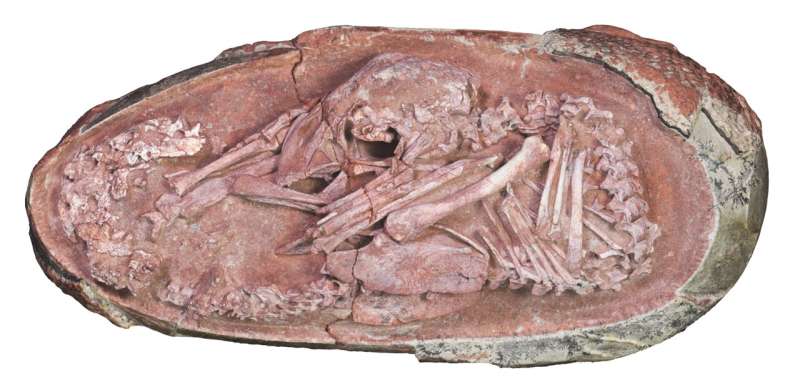A 66- to 72-million-year-old embryo in a fossil dinosaur egg sheds new light on the relationship between modern birds and dinosaur behavior.
The nucleus, nicknamed ‘Baby Yingliang’, was found in the Cretaceous rocks above the Congo in southern China. Toothless Therop dinosaur or Oviropterosaur.
Fossil of one of the most complete dinosaur nuclei ever discovered suggests that these dinosaurs formed bird-like postures near hatching. The discovery is presented in science.
Scientists led by researchers at the University of Birmingham (UK) and the Chinese Geological Survey (Beijing) have discovered that the ‘Baby Yingliang’ pose is unique among known dinosaur nuclei: its head sits under the body, with feet on either side. And the spine curled at the blunt end of the egg. This pose, hitherto unknown to dinosaurs, resembles the embryo of a modern bird.
In modern birds, these postures are associated with the “duck in”, which is controlled by the central nervous system and is critical to the success of hatching. After examining the egg and embryo, the researchers believe that this pre-hatching behavior, which was hitherto considered unique to birds, may have appeared in non-bird theropods.
The embryo is expressed in its life stage without major changes due to the fossil. Estimated to be 27 cm long from head to tail, the creature lays an egg 17 cm long. This specimen is housed in the Yingliang Stone Museum of Natural History.
Fionn Weissma, co-professor and doctoral researcher at the University of Birmingham, explains, “We are thrilled to find that baby dinosaurs have some rare fossils and most of them complete with mutilated bones. , “He said in a statement.
“It’s interesting to see that this dinosaur embryo and a chicken embryo are identical inside the egg, which may indicate similar behaviors before hatching,” he adds.
‘Baby Yingliang’ was identified as an oviroptera based on its deep, toothless skull. Oviraptorosaurs are a group of feathered Therop dinosaurs that are closely related to modern birds, known from the Cretaceous in Asia and North America.
Their distinctive crane shapes and body sizes allowed them to follow a wide variety of diets, including vegetarian, omnivorous and carnivorous.
Birds are known to form a series of folding postures in which they bend their body and bend their head just below the wings, shortly before hatching. Embryos that do not reach these stages are more likely to die because they are not born.
By comparing ‘Babé Yingliang’ to other therobats, long-necked sauropod dinosaurs and bird embryos, the team proposed that duck behavior, which is considered unique to birds, first originated dozens or hundreds of millions of dinosaur dinosaurs. Years. Further discoveries of embryonic fossils would be invaluable in further testing this hypothesis.
Professor Lita Jing, research associate professor at the China University of Earth Sciences (Beijing), explains “The dinosaur embryo was bought by Liang Liu, director of the Yingliang Group, in 2000 as a suspected egg fossil.
During the construction of the Yingliang Stone Natural History Museum in 2010, Museum staff searched the warehouse and found specimens identified as dinosaur egg fossils.Preparation of the fossils was carried out and finally the embryo hidden inside the egg was found. This is how ‘Baby Yingliang’ came to light.
Steve Brusatte, a professor at the University of Edinburgh, is also a member of the study group. “This dinosaur embryo inside its egg is one of the most beautiful fossils I have ever seen. This tiny prenatal dinosaur resembles a baby bird curled up in its egg, which is more proof than many of the characteristic features of today’s birds that they first became dinosaurs. Ancestors,” he explains.
Code of Arms







:quality(85)/cloudfront-us-east-1.images.arcpublishing.com/infobae/KTKFKR763RBZ5BDQZJ36S5QUHM.jpg)